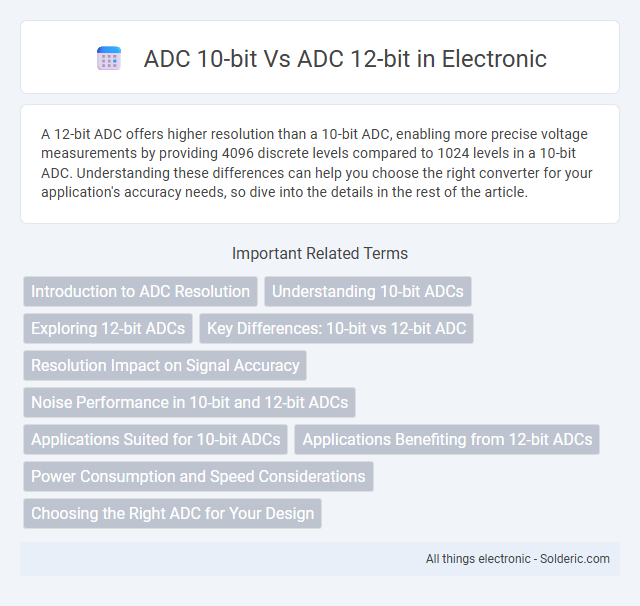A 12-bit ADC offers higher resolution than a 10-bit ADC, enabling more precise voltage measurements by providing 4096 discrete levels compared to 1024 levels in a 10-bit ADC. Understanding these differences can help you choose the right converter for your application's accuracy needs, so dive into the details in the rest of the article.
Comparison Table
| Feature | ADC 10-bit | ADC 12-bit |
|---|---|---|
| Resolution | 1024 levels | 4096 levels |
| Precision | 0.1% (approx.) | 0.024% (approx.) |
| Signal Detail | Lower detail, suitable for general applications | Higher detail, ideal for precision measurement |
| Data Size | 10 bits per sample | 12 bits per sample |
| Conversion Speed | Typically faster due to fewer bits | May be slower, depending on implementation |
| Power Consumption | Lower power in general | Higher power due to increased resolution |
| Common Usage | Basic sensors, audio, control systems | Precision instruments, medical devices, high-res sensors |
Introduction to ADC Resolution
ADC resolution determines the number of discrete values an analog-to-digital converter can produce, directly impacting measurement precision. A 10-bit ADC offers 1,024 quantization levels, while a 12-bit ADC provides 4,096 levels, resulting in finer signal differentiation. Higher bit resolution enhances accuracy in applications requiring detailed analog signal representation, such as audio processing and sensor data acquisition.
Understanding 10-bit ADCs
A 10-bit ADC provides 1024 discrete levels for analog-to-digital conversion, offering sufficient resolution for many standard applications such as audio processing and sensor data reading where moderate precision is adequate. The quantization step size of a 10-bit ADC results in a lower resolution compared to a 12-bit ADC, which has 4096 levels, making 10-bit ADCs more suitable for cost-sensitive or faster sampling scenarios. Understanding the trade-offs between 10-bit and 12-bit ADCs is crucial when selecting components for performance-critical systems, balancing resolution, speed, and power consumption.
Exploring 12-bit ADCs
12-bit ADCs offer a higher resolution of 4096 discrete levels compared to the 1024 levels of 10-bit ADCs, allowing for more precise signal conversion and finer measurement details. This increased resolution enhances accuracy in applications such as sensor data acquisition, audio processing, and instrumentation. Your choice of a 12-bit ADC can significantly improve the quality and reliability of data interpretation in systems requiring detailed quantitative analysis.
Key Differences: 10-bit vs 12-bit ADC
10-bit ADC provides 1,024 discrete levels of signal quantization, whereas 12-bit ADC offers 4,096 levels, significantly enhancing resolution and accuracy in data conversion. The increased bit depth in a 12-bit ADC reduces quantization error and noise, resulting in more precise measurement of analog signals, especially important in applications requiring fine detail. Your choice between 10-bit and 12-bit ADC depends on the balance between system complexity, power consumption, and the required precision for the targeted application.
Resolution Impact on Signal Accuracy
A 12-bit ADC provides 4096 discrete levels compared to 1024 levels offered by a 10-bit ADC, significantly enhancing signal resolution and accuracy. This increased resolution allows for finer differentiation of input signals, reducing quantization error and improving measurement precision in applications such as audio processing and sensor data acquisition. Higher bit-depth in ADCs directly translates to better signal fidelity and more accurate digital representation of analog inputs.
Noise Performance in 10-bit and 12-bit ADCs
Noise performance in 12-bit ADCs generally surpasses that of 10-bit ADCs due to finer resolution, allowing more precise differentiation of signal variations. The increased bit depth in 12-bit ADCs reduces quantization noise, improving signal-to-noise ratio (SNR) by approximately 12 dB compared to 10-bit ADCs. Consequently, 12-bit ADCs are better suited for applications requiring higher accuracy and lower noise, such as precision instrumentation and audio signal processing.
Applications Suited for 10-bit ADCs
10-bit ADCs are ideal for applications requiring moderate resolution with faster sampling rates, such as audio processing, simple sensor measurements, and low-cost consumer electronics. Their 1024 discrete levels offer sufficient accuracy for tasks like temperature monitoring or line-level audio inputs where extreme precision is unnecessary. You benefit from reduced power consumption and lower system complexity in environments where 12-bit resolution is excessive.
Applications Benefiting from 12-bit ADCs
12-bit ADCs provide higher resolution with 4096 discrete levels compared to 1024 levels in 10-bit ADCs, making them essential for precision applications such as medical imaging, instrumentation, and high-fidelity audio processing. These applications require finer signal differentiation to capture subtle variations and improve accuracy and dynamic range. Industrial automation and sensor data acquisition systems also benefit from 12-bit ADCs by enabling more detailed measurements and enhanced control systems.
Power Consumption and Speed Considerations
10-bit ADCs typically consume less power and offer faster conversion speeds compared to 12-bit ADCs, making them suitable for low-power and high-speed applications. The increased resolution of 12-bit ADCs requires more complex circuitry, which generally leads to higher power consumption and slower sampling rates. Designers must balance the need for precision with power efficiency and speed, especially in battery-operated or real-time systems.
Choosing the Right ADC for Your Design
Choosing the right ADC for your design involves balancing resolution and application requirements; a 10-bit ADC offers 1024 discrete levels suitable for less precise measurements, while a 12-bit ADC provides 4096 levels, delivering finer signal detail and improved accuracy. Your choice depends on factors like signal complexity, noise tolerance, and power consumption, as higher-bit ADCs often consume more energy and processing resources. Prioritize a 12-bit ADC when your application demands higher precision and dynamic range, whereas a 10-bit ADC fits cost-sensitive projects with moderate accuracy needs.
ADC 10-bit vs ADC 12-bit Infographic

 solderic.com
solderic.com